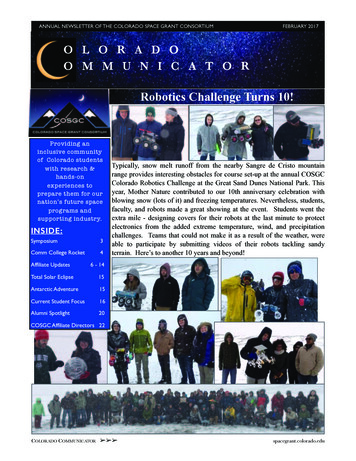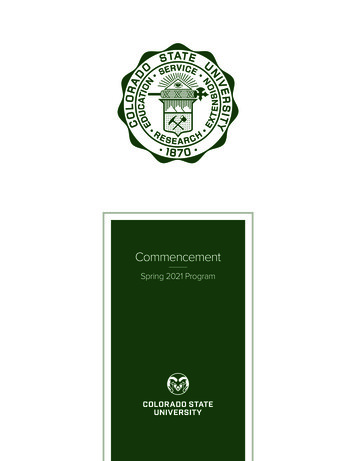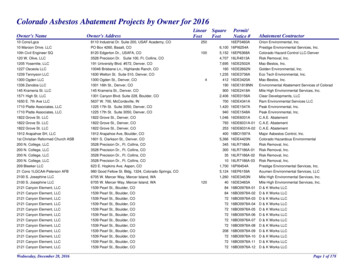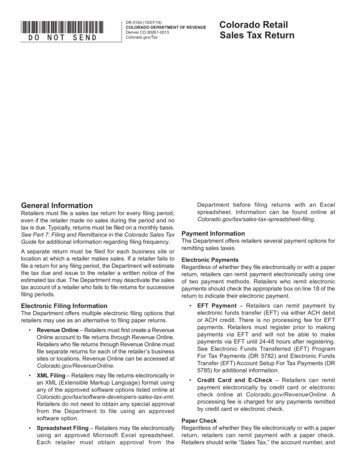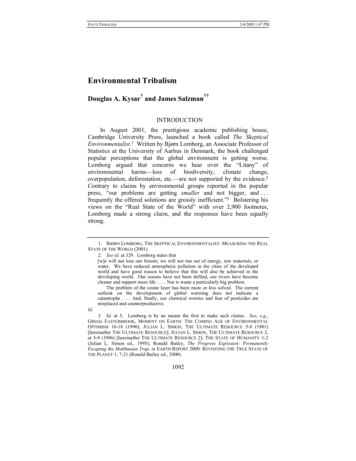
Transcription
ENVTLTRIBALISM3/4/2003 1:47 PMEnvironmental Tribalism†Douglas A. Kysar and James Salzman††INTRODUCTIONIn August 2001, the prestigious academic publishing house,Cambridge University Press, launched a book called The SkepticalEnvironmentalist.1 Written by Bjørn Lomborg, an Associate Professor ofStatistics at the University of Aarhus in Denmark, the book challengedpopular perceptions that the global environment is getting worse.Lomborg argued that concerns we hear over the “Litany” ofenvironmental harms—loss of biodiversity, climate change,overpopulation, deforestation, etc.—are not supported by the evidence.2Contrary to claims by environmental groups reported in the popularpress, “our problems are getting smaller and not bigger, and . . .frequently the offered solutions are grossly inefficient.”3 Bolstering hisviews on the “Real State of the World” with over 2,900 footnotes,Lomborg made a strong claim, and the responses have been equallystrong.1. BJØRN LOMBORG, THE SKEPTICAL ENVIRONMENTALIST: MEASURING THE REALSTATE OF THE WORLD (2001).2. See id. at 329. Lomborg states that[w]e will not lose our forests; we will not run out of energy, raw materials, orwater. We have reduced atmospheric pollution in the cities of the developedworld and have good reason to believe that this will also be achieved in thedeveloping world. Our oceans have not been defiled, our rivers have becomecleaner and support more life . . . . Nor is waste a particularly big problem.The problem of the ozone layer has been more or less solved. The currentoutlook on the development of global warming does not indicate acatastrophe . . . . And, finally, our chemical worries and fear of pesticides aremisplaced and counterproductive.Id.3. Id. at 5. Lomborg is by no means the first to make such claims. See, e.g.,GREGG EASTERBROOK, MOMENT ON EARTH: THE COMING AGE OF ENVIRONMENTALOPTIMISM 16-18 (1996); JULIAN L. SIMON, THE ULTIMATE RESOURCE 5-8 (1981)[hereinafter THE ULTIMATE RESOURCE]; JULIAN L. SIMON, THE ULTIMATE RESOURCE 2,at 5-9 (1996) [hereinafter THE ULTIMATE RESOURCE 2]; THE STATE OF HUMANITY 1-2(Julian L. Simon ed., 1995); Ronald Bailey, The Progress Explosion: PermanentlyEscaping the Malthusian Trap, in EARTH REPORT 2000: REVISITING THE TRUE STATE OFTHE PLANET 1, 7-21 (Ronald Bailey ed., 2000).1092
ENVTLTRIBALISM2003]3/4/2003 1:47 PMENVIRONMENTAL TRIBALISM1093The Economist, for instance, called it “one of the most valuablebooks on public policy—not merely on environmental policy—to havebeen written for the intelligent general reader in the past ten years . . .‘The Skeptical Environmentalist’ is a triumph.”4 Not to be outdone, theBritish newspaper, The Daily Telegraph, called it “probably the mostimportant book on the environment ever written.”5 A host of otherpublications and, notably, conservative groups similarly lauded thebook’s merits.6 This adulation was countered by equally zealouscondemnation. A review in the eminent scientific journal, Nature,denounced the book as “deeply flawed” and implicitly likened Lomborgto Holocaust deniers.7 Under the heading, “Science defends itself againstThe Skeptical Environmentalist,” Scientific American devoted a specialsection of eleven pages to critiques of Lomborg’s treatment of climatechange, biodiversity, and other topics.8 Equally critical articles andreports were published around the globe (including one by Lomborg’sown former colleagues at the University of Aarhus).9 Such detractorsargued that Lomborg’s “Litany” was an outdated list of straw men, his4. Doomsday Postponed, THE ECONOMIST, Sept. 8, 2001, at 89, 89-90.5. Matt Ridley, The Greens Have Got It Wrong, THE DAILY TELEGRAPH (UK),Aug. 25, 2001, available at http://www.telegraph.co.uk.6. For instance, the New York Times hailed The Skeptical Environmentalist as “asubstantial work of analysis” that exposes the “urban myths” of the environmental agenda.Nicholas Wade, Bjorn Lomborg: From an Unlikely Quarter, Eco-Optimism, N.Y. TIMES,Aug. 7, 2001, at F1 (book review). A reviewer in the Washington Post agreed, calling thework a “massive, meticulously presented argument,” “a factual encyclopedia,” “amagnificent achievement,” and “the most significant work on the environment since . . .Rachel Carson’s Silent Spring, in 1962.” Denis Dutton, Greener Than You Think, WASH.POST, Oct. 21, 2001, at BW1 (book review). Ronald Bailey of the Competitive EnterpriseInstitute concluded that Lomborg’s “magnificent and important book . . . deals a majorblow to [environmentalism] by superbly documenting a response to environmentaldoomsaying.” Ronald Bailey, Debunking Green Myths: An Environmentalist Gets ItRight, REASON, Feb. 2002, at 58, 58 (book review). More recently, Judge Alex Kozinskiprovided a particularly laudatory review in the pages of the Michigan Law Review, callingThe Skeptical Environmentalist “an indispensable resource” that provides “a balanced,thoughtful approach to environmental problems.” Alex Kozinski, Gore Wars, 100 MICH.L. REV. 1742, 1746 (2002) (book review).7. “The text employs the strategy of those who, for example, argue that gay menaren’t dying of AIDS, that Jews weren’t singled out by the Nazis for extermination, and soon.” Stuart Pimm & Jeff Harvey, No Need to Worry About the Future, 414 NATURE 149,149 (2001). A commentator in the Weekly Standard, in turn, defended Lomborg bycomparing environmentalists to followers of “fanatical Islam.” James K. Glassman, GreenWith Rage, WKLY. STANDARD, Feb. 25, 2002, at 14, 16.8. See John Rennie, Misleading Math About the Earth: Science Defends ItselfAgainst the Skeptical Environmentalist, SCI. AM., Jan. 2002, at 61, 61.9. A number of these critiques have been posted on the web at http://www.antilomborg.com/. A particularly accessible account comes from Tom Burke. See TomBurke, Ten Pinches of Salt: A Reply to Bjorn Lomborg, at ten%20pinches%20of%20salt.pdf.
ENVTLTRIBALISM10943/4/2003 1:47 PMMINNESOTA LAW REVIEW[Vol 87:1092use of data was misleadingly selective, his treatment of issues showedbasic scientific ignorance, and worse.10 The most demonstrative negativereview came in the form of a pie thrown in Lomborg’s face during abook signing event at Oxford.11Given Lomborg’s claims, it’s not surprising that reactions to hisbook—ranging from a threatened boycott of Cambridge UniversityPress12 to the Danish government’s appointment of Lomborg to head anew national environmental institute13—have been so strong. What hasbeen surprising, though, is the starkly bipolar nature of the reactions, forthere are precious few moderate reviews or stories to be found on TheSkeptical Environmentalist. It seems either to be described as a carefullyresearched unmasking of the environmental movement’s scare tactics oras an unprincipled, ill-informed, tendentious book.14 Viewed from theoutside, Lomborg’s book seems to have acted as a “cutting gate”—themechanism used by ranchers to divide cattle into separate pens. Putsimply, you either love it or you hate it. While the remarkably binaryresponse to The Skeptical Environmentalist may be an extreme example,it certainly is not an isolated one. Indeed, it says a lot about the nature ofthe environmental debate at the turn of the twenty-first century.1510. “As science writing goes, The Skeptical Environmentalist is C-minus stuff, asstraight-forward and lackluster as a 10th-grade term paper.” Kathryn Schulz, Let Us NotPraise Infamous Men: On Bjorn Lomborg’s Hidden Agenda, GRIST MAG., Dec. 12, 01.asp.11. See Russ Baker, The Lomborg File: When the Press is Lured by a Contrarian’sTale, 40 COLUM. JOURNALISM REV. 78, 78 (2002).12. See Andrew Goldstein, Danish Darts, TIME, Aug. 26, 2002, at A60, A60.13. See Kozinski, supra note 6, at 1745-46 n.20.14. Compare id. at 1746 (describing Lomborg’s book as “a devastating critique ofthe environmental scare-mongering of the last three decades”), Bailey, supra note 6, at 59(“[Lomborg] shows how, time and again, ideological environmentalists misuse, distort,and ignore the vast reams of data that contradict their dour visions.”), Dutton, supra note6, at BW1 (“Lomborg found on close analysis that the factual foundation on which theenvironmental doomsayers stood was deeply flawed: exaggeration, prevarications, whitelies and even convenient typographical errors had been absorbed unchallenged into thefolklore of environmental disaster scenarios.”), and Charles T. Rubin, Green No More:The Education of an Environmentalist, WKLY. STANDARD, Dec. 24, 2001, at 33, 33(“Lomborg skillfully uncovers the source of the bias toward bad environmental news inthe scientific community, environmental interest groups, and the media.”), with ThomasLovejoy, Biodiversity: Dismissing Scientific Progress, SCI. AM., Jan. 2002, at 69, 71(“Lomborg seems quite ignorant of how environmental science proceeds . . . .”), Pimm &Harvey, supra note 7, at 149 (“Like bad term papers, Lomborg’s text relies heavily onsecondary sources.”), Rennie, supra note 8, at 61 (noting that “many” scientists spoke toScientific American and complained of Lomborg’s “misrepresentation of their fields,” his“incomplete use of the data,” and his “misunderstanding of the underlying science”), andStephen Schneider, Global Warming: Neglecting the Complexities, SCI. AM., Jan. 2002, at62, 62 (“Lomborg admits, ‘I am not myself an expert as regards environmentalproblems’—truer words are not found in the rest of the book . . . .”).15. Many of the books cited supra note 3, for instance, triggered binary responses
ENVTLTRIBALISM2003]3/4/2003 1:47 PMENVIRONMENTAL TRIBALISM1095Despite over three decades of modern environmental laws, theproliferation of citizens groups, think tanks, and other organizationsconcerned with environmental issues, and the maturation ofenvironmental law and policy into distinct fields of study, one still seesbasically two warring camps, both politically and ideologicallyentrenched on opposite ends of the environmental battlefield. In manyrespects, the Lomborg conflict is simply the most recent example of thissort of staunch “environmental tribalism.”We are surely not the first to notice the polarization ofenvironmental policy and its scorched earth consequences. For instance,Dan Farber has described the conflict between “tree huggers” and “beancounters” as a fundamental divide over whether environmental law andpolicy should be determined by “willingness to vote” or “willingness topay.”16 Bob Percival and his casebook co-authors have framed theconflict as arising between proponents of “moral outrage” and “coolanalysis.”17 Rob Verchick has described the divide as one of the“philosophies of Feathers and Gold.”18 In this issue, Chris Schroederdistinguishes between environmental “priests” and “philosophers.”19The downside to such fierce tribal alliances is not simply that they makethe field unpleasant for those who try to bridge the divide. Rather, thedanger is that actual environmental policy outcomes are often found inthe unprincipled mishmash lying on the battlefield after adversarialcombat, rather than in measures designed specifically to be pragmatic,pluralistic responses to environmental problems. As J. B. Ruhl, who hasargued for the creation of a “radical middle” to break this tribal deadlock,bluntly complains, “I, for one, am not sure that the annihilation process inenvironmental law will ever come to an end as long as it is framed bytwo opposing philosophies and a vacuum in the middle and, frankly, I amsick of it.”20Well, we are too. But we wonder whether environmental tribalismcan be replaced by a “radical middle” or “eco-pragmatic” approachsimply because it makes so much sense to do so. Put another way, whilesimilar to the recent Lomborg brouhaha.16. DANIEL A. FARBER, ECO-PRAGMATISM 39-42 (1999).17. ROBERT V. PERCIVAL ET AL., ENVIRONMENTAL REGULATION: LAW, SCIENCE,AND POLICY 73 (3d ed. 2000).18. Robert R. M. Verchick, Feathers or Gold? A Civic Economics for EnvironmentalLaw, 25 HARV. ENVTL. L. REV. 95, 96 (2001).19. Christopher H. Schroeder, Prophets, Priests and Pragmatists, 87 MINN. L. REV., 5-6 (2003).20. J. B. Ruhl, Working Both (Positivist) Ends Toward a New (Pragmatist) Middle inEnvironmental Law, 68 GEO. WASH. L. REV. 522, 524 (2000) [hereinafter, PragmatistMiddle]; see also J. B. Ruhl, A Manifesto for the Radical Middle, 38 IDAHO L. REV. 385,385-86 (2002) [hereinafter, Radical Middle].
ENVTLTRIBALISM10963/4/2003 1:47 PMMINNESOTA LAW REVIEW[Vol 87:1092the apt categories listed above of bean counters, priests, feathers, andoutrage are surely accurate descriptions of the poles of environmentaladvocacy, they don’t strike us as a broader explanation for the bipolardynamic. What interests us, therefore, is why the environmental field sooften seems to operate as a cutting gate, why it creates such fertile terrainfor tribal behavior, and how it can be broadened to include other voices.Without understanding the factors driving the environmental cutting gate,it is difficult to assess whether eco-pragmatic proposals can succeed inenvironmental policymaking simply on the strength of their own merits.In this regard, consider how environmental protection differs fromother strongly divisive public issues. It is, of course, not unusual to havestrong advocacy at both ends of a contested issue. Look at the publicdebates over abortion, the death penalty, or gun control—such fields alsoseem dominated by loud “pro” and “anti” voices. But let’s look moreclosely at the abortion debate, which on its face seems pretty similar. Itis certainly hard to find a more “theological” topic that pits differingworldviews against each other. As a useful comparison to environmentaldisputes where feelings run high (such as drilling for oil in the ArcticNational Wildlife Refuge21), so far so good. Notice, however, theinteresting difference that in the abortion field, the general public is alsopolarized, with feelings running strongly either that abortion istantamount to murder or that (up to a certain stage) it is simply a medicaltreatment within the discretion of the mother.22 In the environmentalfield, by contrast, most of the public is not similarly polarized. In fact,polls show a consistently high level of support for environmentalprotection,23 and that is what makes the cutting gate phenomenon inenvironmental law and policy so surprising.On the topic of abortion, the advocacy dynamic seems to mirror21. See infra text accompanying note 59.22. See Lydia Saad, Public Opinion About Abortion—An In-Depth Review, mmaries/sr020122.asp (reporting resultsof an August 2001 Gallup survey in which 46% of respondents considered themselves tobe pro-choice, while 46% called themselves pro-life); see also id. (reporting results of May2001 Gallup survey in which 42% of respondents stated that abortion is morallyacceptable, while 45% felt that it is morally wrong).23. Chris Schroeder has gathered an extensive array of opinion poll data supportingthe assertion that “Americans from every demographic, socioeconomic, racial, and ethniccategory identify themselves as concerned about the environment . . . .” Christopher H.Schroeder, Clear Consensus, Ambiguous Commitment, 98 MICH. L. REV. 1876, 1876,1896-1906 (2000). As the title of his review indicates, however, Schroeder also notes thatthe ultimate strength of public environmental commitment “is ambiguous becauseAmericans have not thoroughly considered how they would trade competing values withenvironmental values in hard cases.” Id. at 1905. In Part II, we argue that such hard casedecisions do not receive public attention and deliberation largely because bean countersand tree huggers fail to frame environmental issues in ways conducive to frank democraticdiscussion.
ENVTLTRIBALISM2003]3/4/2003 1:47 PMENVIRONMENTAL TRIBALISM1097broader public perceptions. On the environment, however, that does notseem to be the case, as political advocacy by bean counter and treehuggers tribes alike seems more extreme and more polarized than thepublic constituencies these groups claim to represent. More interestingstill, the groups that could claim to speak for this great silent majoritycannot seem to make it on the political stage. Thus, we have a growingnumber of leading environmental law and policy scholars calling for apragmatic, centrist approach.24 We have a public that seems to widelysupport just such an approach.25 Yet environmental advocacy seems toremain largely a tribal battleground. Why is that? And, more germane tothis Symposium issue, what does that mean for the prospects of an ecopragmatic approach successfully passing through the cutting gate?Our exploration of these issues proceeds in two parts. In Part I, wedescribe in more detail what we mean by environmental tribalism,focusing on reactions to The Skeptical Environmentalist as an illustrativeexample. Part II then examines the dynamics that drive the cutting gatephenomenon and reinforce tribal behavior. We conclude by noting thatthe social dynamics described in Part II tend to block both the emergenceand acceptance of eco-pragmatism at the level of public advocacy. Weargue, therefore, that scholars and others seeking to advance the cause ofthe “radical middle” should focus their efforts in those areas whereenvironmental tribalism is least entrenched and pragmatism mostappreciated—at the level of policy implementation.I. TRIBALISM IN ENVIRONMENTAL LAW AND POLICYWhat would an anthropologist make of the furor surrounding TheSkeptical Environmentalist? Our sense is that she might describe the twogroups of critics and champions (whether labeling them as tree huggers,priests, or some other clever moniker) as operating effectively likemodern-day tribes.26 It seems clear that those in the environmental24. See, e.g., FARBER, supra note 16, at 9; Radical Middle, supra note 20, at 387;Pragmatist Middle, supra note 20, at 545-46. While the proposals of Farber and Ruhlhave significant differences, their main insight is similar—an effective, balancedenvironmental policy should result from considered deliberation rather than ad hoccompromise between polar extremes.25. See infra text accompanying notes 101-102.26. Zyg Plater made a similar observation about environmental advocacy in a 1990article examining the role of local groups in resource management conflicts through casestudies of the Exxon Valdez, old growth logging, and the snail darter. See Zygmunt Plater,A Modern Political Tribalism in Natural Resources Management, 11 PUB. LAND L. REV.1, 6-17 (1990). He described tribalism as “a cohesive instinctive affiliation betweenpeople based on their recognition of and loyalty to common roots, a narrowed, nonofficial, racial, social and cultural allegiance that has evolved to have remarkable stayingpower and utility.” Id. at 5. Correspondingly, though, he noted that tribalism entailsexclusion and distrust of non-tribe members: “[P]eople who are not of the tribe can be
ENVTLTRIBALISM10983/4/2003 1:47 PMMINNESOTA LAW REVIEW[Vol 87:1092policy field already think about themselves and their opponents in tribalterms. Just look at the debate over The Skeptical Environmentalist. Inthe introduction to his book, Lomborg describes himself as an “old leftwing Greenpeace member” who had unthinkingly bought into the“Litany.”27 While Lomborg apparently includes this self-description toexplain how he became interested in the book project, it is fascinatingthat his former association with Greenpeace has featured so prominentlyin both the praise and condemnation surrounding the book. A LEXISsearch turned up no less than 154 stories from around the globe thatnoted Lomborg’s association with Greenpeace, including prominent massmedia sources like Time, international publications like The Australianand The Times of London, and more obscure outlets like FertilizerInternational. Across the spectrum, commentators seemed keenlyinterested in the nature of Lomborg’s relationship to the Greenpeaceorganization, which is, after all, one of the most prominent clans of thetree hugger tribe. Indeed, Cambridge University Press noted Lomborg’smembership in Greenpeace prominently in its publicity and, recognizingthe value of a turncoat, many adulatory reviews have presented hisformer affiliation as proof of his credentials. The American EnterpriseInstitute (AEI), a conservative think tank, went so far as to call Lomborg“a wonderful witness for the prosecution.”28 Interestingly, Lomborg’saffiliation with Greenpeace came up in many negative reviews, as well,with Lomborg attacked as not “really” a member of Greenpeace eitherbecause he only paid dues or because he was not an activist.29Why do both sides care so much about whether or not Lomborg“really” belonged to a mass membership organization like Greenpeaceyears before he wrote the book? A likely reason, it seems to us, is thatmembership in Greenpeace serves as a badge of tribal affiliation. Todefenders of Lomborg, not only has he worn the other tribe’s colors but,more important, he now denounces their creed. They seem to be thinkingthat, when it comes to matters of environmental importance, Lomborgshould know since, after all, he was once “one of them.”30 To critics ofprecluded from consideration, are not owed the same deference as human beings who aremembers of the tribe; they are in some sense ‘alien,’ and their interests are excluded fromrecognition in the process of governance.” Id.27. LOMBORG, supra note 1, at xix.28. Glassman, supra note 7, at 16.29. See, e.g., Earthbeat, Skeptical Environmentalist Debates Critics, Oct. 13, 2001, 394496.htm (quoting Tom Burke as saying“I’ve actually talked to Greenpeace, and they are very clear that they have no record ofBjorn Lomborg . . . as an activist member. Now he may have contributed money toGreenpeace . . . but . . . before you call yourself an environmentalist you have to do a littlebit more than contribute money.”).30. Similar examples of misguided pasts might include, “Pacifist Joins the Marines”or “Vegetarian Becomes Big Mac Lover.”
ENVTLTRIBALISM2003]3/4/2003 1:47 PMENVIRONMENTAL TRIBALISM1099Lomborg, on the other hand, he never really was part of the tribe in thefirst place, perhaps writing a membership check but not adequatelyparticipating in the requisite initiation rites. He therefore cannot speakfor the tribe because he never truly belonged. Are we taking the tribalmetaphor too far? Perhaps, but how else can one explain the fixation onLomborg’s relationship with Greenpeace—a matter wholly unrelated tothe merits of his argument—if not as an attempt on both sides to identifywhich tribe he belongs to (and therefore can speak on behalf of)?The tribal dynamic goes beyond mere membership in an exclusivegroup. As discussed in more detail in the sections that follow, tribalaffiliation is also expressed through the sharing of a common worldview(what in a religious context we might call a dogma or orthodoxy). Mostof Lomborg’s critics, we expect, would support the notion that the earth’senvironment has a finite carrying capacity and that there are biophysicallimits to growth that in a number of cases we are approaching or haveexceeded.31 Many of Lomborg’s supporters, on the flip side, likely viewthe world through the perspective of resource economics, confident in thebelief that any particular resource constraint can be circumvented throughmarket mechanisms and that human ingenuity is the greatest resource ofall.32In addition to common shared assumptions, tribal advocacy alsoreveals itself through a ready acceptance of conclusions based onperceived tribal membership of a speaker and, relatedly, a strongreluctance to admit shortcomings in fellow tribe members’ work. Theseaspects of the environmental movement have been pointed out in anewsletter of the AEI that described the worldview of environmentalgroups as an “uncompromising viewpoint” that “gives rise to what mightbe called environmental correctness . . . . Disagreement with thatviewpoint is ascribed to a moral defect.”33 However accurately thisdescription may fit parts of the tree hugger tribe, it is interesting to notethat the AEI authors do not appear to see the same dynamics happeningamong bean counters as well.A further feature of environmental tribalism takes the form of a31. See, e.g., John P. Holdren, Energy: Asking the Wrong Question, SCI. AM., Jan.2002, at 65, 65 (“What environmentalists mainly say on [the topic of resource scarcity] isnot that we are running out of energy, but that we are running out of environment . . .running out of the capacity of the air, water, soil and biota to absorb, without intolerableconsequences for human well-being, the effects of energy extraction, transport,transformation and use.”).32. See, e.g., Kozinski, supra note 6, at 1752-53 (arguing that advances intechnology, the ability to substitute resource inputs, and efficiency gains in the use ofresources mean that, in the long run, “prices for materials always drop”).33. Steven F. Hayward & Christopher DeMuth, AEI’s Environmental PolicyOutlook, July 2002, at http://www.aei.org/epo/epo14224.htm.
ENVTLTRIBALISM11003/4/2003 1:47 PMMINNESOTA LAW REVIEW[Vol 87:1092strong skepticism of people who employ the methodologies or languagesof competing tribes. This is evident in the educational training andprofessional affiliations of Lomborg’s supporters and critics. In lookingat the background of book review authors, with rare exceptions,Lomborg’s critics all have been scientists and professional staff membersof environmental organizations. Their strongest consistent criticism hasbeen Lomborg’s lack of scientific understanding, as demonstrated by hislack of scientific credentials and the fact that he has never published in anacademic journal on environmental issues. Lomborg supporters, on theother hand, have largely been social scientists (primarily, economists andpolitical scientists), and they have praised Lomborg for his focus on hardnumbers and technical assessment of the costs and benefits ofenvironmental regulation.34 It is evident from reading even a handful ofthese reviews that neither group particularly trusts the other’smethodologies, assumptions, or intentions.While comparing environmental advocacy to a tribal dynamic is, webelieve, a useful means for describing the seemingly unbridgeable divideacross environmental policy, there are at least three important caveats tokeep in mind. First, there is an important distinction between tribalidentification and the more common phenomenon of interest groupidentification. One can point to many advocacy groups that share apolitical goal but do not necessarily share tribal characteristics. Comingtogether in a common political cause, such as advocating for a higherminimum wage, frequently occurs without producing the same socialdynamics that one observes in the environmental field. Somethingdifferent seems to be at work here. Second, we are by no meanssuggesting that people in the environmental field are unthinking acolyteswho fervently bow at the altar and mouth their tribe’s dogma. Yes,Virginia, we do have free will. Those within the environmentalistcommunity often differ on specific issues, as do those who fall within thebean counter tribe. Nevertheless, despite these individual variations,social forces clearly are at work within the field that tend to reproducetribal behavior time after time and, importantly, that seem also to impedethe development of more integrated, inclusive advocacy. Third, whilethe tribalism phenomenon creates an impression that environmentalprotection is divisive and polarized throughout the field, a middle doesexist, of course, between the two poles of the environmental spectrum.As we discuss at the end of this Article,35 this is most evident at thepolicy implementation level, where compromise happens quite often andmight even be described as the way of the world. Our initial focus,34. Some representative sources on both sides of the Lomborg debate are gatheredsupra note 14.35. See infra text accompanying notes 119-121.
ENVTLTRIBALISM2003]3/4/2003 1:47 PMENVIRONMENTAL TRIBALISM1101however, is at the public advocacy level. It is here, we contend, that thecutting gate continues to operate and that the level of discourse has longremained bipolar.II. THE CUTTING GATEWhile modern environmental law may have been ushered intoexistence by “an orgy of consensus,”36 its recent public visage moreclosely resembles a stockyard. Just as cattle are deftly herded intoseparate pens by a cutting gate, participants in environmental law andpolicy debates often seem to respond to a cutting gate of their own, a setof values, beliefs, or characteristics that divide them neatly into pens of“bean counters” and “tree huggers,” to use Farber’s evocative distinction.Occasionally, some salient event like the release of The SkepticalEnvironmentalist shines an especially bright light on these pens,exposing both the deep divisions within the environmental law andpolicy community and the mudslinging, caterwauling, grunting, andgroaning that exist between them. What is not so clearly revealed,however, are the dynamics that drive the cutting gate phenomenon in thefirst place. Only by better understanding the forces that driveenvironmental advocates farther apart can one identify where ecopragmatic approaches will be most likely to succeed. The followingsections explore this issue by reviewing a variety of explanations, bothold and new, for the cutting gate phenomenon (many of which werenoted by Farber in his keynote presentation to this symposium).37A. ADVERSARIAL POLICYMAKINGA common explanation for the cutting gate is the fact thatenvironmental policy tends to be formed within highly contested,adversarial settings. Under such conditions, extremism is a strategicallyeffective form of advocacy and
'The Skeptical Environmentalist' is a triumph."4 Not to be outdone, the British newspaper, The Daily Telegraph, called it "probably the most important book on the environment ever written."5 A host of other publications and, notably, conservative groups similarly lauded the book's merits.6 This adulation was countered by equally zealous
